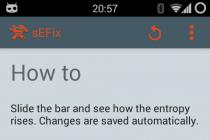Xiaomi introduced USB Type-C headphones to the Indian market with noise canceling and superior sound quality. What is so interesting about them? Let's take a closer look.
These wired headphones The earbuds were specially launched with the Mi Mix 2 in mind, because the smartphone has a USB Type-C port instead of a 3.5mm audio jack.
According to analytics, 32% of Xiaomi mobile phone users prefer USB Type-C headphones.
The body of the headset is made of titanium, which guarantees resistance to scratches and corrosion. The range of reproducible frequencies is 20-40,000 Hz with a sensitivity of 113 dB. Thanks to the active noise canceling (ANC) function, the headphones are able to suppress external noise.
The earbuds are compatible with most Xiaomi smartphones that have a USB Type-C port:
- Mi Mix 2,
- Mi Mix,
- Mi 6,
- Mi 5,
- Mi 5s,
- Mi 5s Plus,
- Mi Note 2.
However, they are not compatible with Redmi 5X and Redmi Pro.
The headphones have a micromechanical noise canceling module that easily cope with blocking out ambient noise. When the mode is turned on, noises with a power of 25 dB are suppressed, with a frequency range from 50 to 2000 Hz.

Mi Noise Canceling USB Type-C Wired Headset is also not compatible with Redmi 4C and Redmi 4S. You will be able to listen to music and the active noise canceling function will work. However, you will not be able to receive calls or control music using the built-in remote.
The headphone cable is made of environmentally friendly material that is completely non-toxic. In addition, to achieve the best sound a digital decoder is installed in the headphones.

The cost of the accessory is about $ 45. In general, for this price, not bad at all. Good build quality, active noise canceling, remote control and function hardware decoding sound to improve its sound.
The process of mass adoption of the USB interface in PCs and peripherals began in the late 90s of the last century. Only a few years have passed, and USB has become the de facto standard for connecting peripheral devices, practically replacing other solutions such as serial and parallel ports, PS / 2, etc.
Moreover, the business was not limited to computers and peripheral equipment. Convenience, ease of connection and versatility of the USB interface contributed to the spread of this solution in other areas, in particular, in mobile devices, consumer audio and video equipment, automotive electronics, etc.
Since the process of improving PCs, mobile devices and other equipment is constantly going on, from time to time it becomes necessary to refine the USB interface in order to improve key characteristics (in particular, throughput), expand functionality, introduce new connectors, etc. All this allows adapting the existing solution to the changing needs of the industry.
One of the most notable innovations in recent years is the introduction of the SuperSpeed mode, which appeared in the USB 3.0 specification. The final text of this document was approved at the end of 2008, and over the next couple of years this decision was widely disseminated.
However, a lot of time has passed since then, and the time has come for the next improvements. In the coming year, the IT industry and you and I will have a number of revolutionary innovations without exaggeration. We will talk about them in this review.
SuperSpeedPlus Mode
In the summer of 2013, the USB specification version 3.1 was approved. The main innovation that this document legitimized was the SuperSpeedPlus mode, which doubles the bandwidth of the USB data transfer bus: from the previous 5 to 10 Gb / s. For compatibility with older equipment, it is possible to work in SuperSpeed mode (up to 5 Gb / s). Thus, a USB 3.1 connection will allow (at least theoretically) to transfer data at speeds over 1 GB / s and practically reach the interface in terms of this indicator. HDMI version 1.4 (the bandwidth of which is 10.2 Gbps).
What does this mean in practice? 10 Gbps bandwidth is enough for broadcasting high-definition video (Full HD) with a frame refresh rate of up to 60 Hz or stereoscopic recordings in the same resolution with a frequency of up to 30 Hz. Accordingly, USB 3.1 can be considered as a full-fledged alternative to specialized interfaces (such as DVI and HDMI) for broadcasting video signals high resolution from PCs and mobile devices to monitors, projectors and other devices.
USB Type C connector
One of the revolutionary innovations that will affect the field of PCs, as well as peripheral and mobile devices in the near future is the introduction of a new type of USB interface connector. The USB 3.0 Type C plugs and receptacle specification was developed by the USB 3.0 Promoter Group and was finalized in August 2014. The design of USB Type C connectors has a number of important features that it makes sense to talk about in detail.

First, USB Type C plugs and sockets are symmetrical. In a USB Type C socket, the plastic tongue is located exactly in the middle, and the contact pads are located on both sides. Thanks to this, the plug can be plugged into such a socket both in a straight position and in an inverted position by 180 °. This will greatly simplify the lives of users, who will finally be relieved of the need to guess the correct orientation of the plug at random (which is especially important when connecting cables to system unit installed under the table).

Secondly, the USB Type C specification calls for the use of balanced cables that have the same plugs on both sides. Accordingly, the sockets installed on the host devices and on the peripheral equipment will be the same.

And thirdly, the USB Type C connector will not have mini and micro versions. It is envisioned that USB Type C outlets and plugs will be the same for desktop and laptop PCs, peripherals, home appliances, mobile devices, power supplies, and more. Accordingly, only one unified cable is required to connect devices of any type.


The dimensions of the USB Type C socket are approximately 8.4x2.6 mm, which allows you to easily place it in the case of even small-sized devices. Several design options are available for surface mounting printed circuit board, and in a special cutout (the latter option allows you to reduce the thickness of the device body).

The design of USB Type C plugs and sockets is designed for 10 thousand connections and disconnections - which corresponds to the reliability indicators of USB connectors currently used.

The first public demonstration of USB Type C connectors and cables took place as part of the IDF Fall 2014 Forum, which was held in early September in San Francisco (USA). One of the first mass-produced devices equipped with a USB Type C connector was the tablet announced in mid-November.
Of course, the physical incompatibility of the USB Type C connector with older types of outlets is not the best news for end users... Nevertheless, the developers from the USB 3.0 Promoter Group decided to take such a radical step in order to expand the functionality of the USB interface, as well as create a reserve for the future. To connect new devices to equipment equipped with connectors of older types, adapter cables will be produced (USB Type C - USB Type A, USB Type C - USB Type B, USB Type C - microUSB, etc.).
USB Power Delivery 2.0
One of the reasons for the current popularity of the USB interface is the ability to transfer not only data, but also power over a single cable. This allows you to simplify the connection procedure as much as possible and reduce the number of wires used. When working with mobile devices, this property of the USB interface provides the ability to transfer and synchronize data with a PC, and at the same time recharge the gadget's battery by connecting just one cable. The same can be said about the low-power periphery. Thanks to the ability to transmit power via the interface cable, we have long been relieved of the need to use external power supplies for some peripheral devices - in particular, flatbed scanners, low-power speaker systems, etc. Due to this, it was possible to reduce not only the number of wires on the desktop, but also the occupied sockets under it.
However, the rapid development of mobile devices in recent years has led to a significant change in the requirements not only for the bandwidth of the data bus, but also for the parameters of the power supply supplied over the USB connection. For charging low-power devices (such as MP3 players or wireless headsets), a current of 500 mA is quite enough (and this, recall, is the maximum value for standard USB ports 1.1 and 2.0). However, for normal charging of modern smartphones and tablets, power supplies are required that can deliver a current of 2 A or more.
A similar situation is observed in the segment of peripheral devices. The USB power is sufficient to power the 2.5 '' external hard disk or desktop flatbed scanner with CIS type sensor. However, supplying electricity to a small jet printer or, for example, an LCD monitor, the USB interface does not even allow version 3.0 (and in it the maximum current was increased to 900 mA per port).
In order to expand the capabilities of the USB interface to provide power to external devices, the USB Power Delivery 2.0 specification was developed. This document regulates the supply of power to devices with a power consumption of up to 100 W, and in any direction - both from the host device to the peripheral, and vice versa. For example, a laptop can be powered by a monitor to which it is connected via USB.
Of course, the ability to supply power to external devices is limited. design features A PC or other device that acts as a power source. That is why the USB Power Delivery 2.0 specification provides three profiles - for devices with a power consumption of up to 10, 60 and 100 watts. In the first case, the supply voltage is 5 V, and the maximum current in the load circuit can reach 2 A. The second profile provides for the use of a supply voltage of 12 V, and the third - 20 V. The maximum current in the load circuit in both cases is limited to 5 A.
It should be noted that in order to power a heavy load, both devices must support the corresponding USB Power Delivery 2.0 profile. Obviously, the maximum power will be limited by the capabilities of the device acting as a power source. There are other aspects to keep in mind as well.
In the event that the current in the power circuit does not exceed 2 A, USB connectors of any currently existing types can be used to connect devices. Connecting a more powerful load is possible only through the USB Type C connectors (which were already mentioned above) and the corresponding cables. It is also necessary to pay attention to the fact that, unlike USB Type C connectors, the design of standard cables is designed for a maximum current of 3 A. Thus, to connect a more powerful load, you will need a special cable.
The introduction of the USB Power Delivery 2.0 specification will significantly expand the possibilities for transferring power over the USB interface bus. The implementation of this solution in the future will make it possible to use the USB ports of a desktop computer to recharge not only smartphones, tablets, etc. gadgets, but also mobile PCs - netbooks, laptops, etc. In addition, the range of peripheral devices will be significantly expanded, which can receive the current required for operation via the USB interface bus and, accordingly, do without separate power supplies. LCD monitors with active acoustic systems etc.
Alternative modes
Another important innovation that will become available with the transition to the use of the USB Type C connector is support for functional extensions (Functional Extensions). A special case of functional extensions are the so-called Alternate Modes (AM). With their help, manufacturers will be able to use the physical connection of the USB interface to implement the specific capabilities and functions of certain devices.
For example, alternative Audio mode Adapter Accessory Mode allows you to use a physical USB connection to broadcast analog sound signal headphones, external speakers and other equipment. To a device equipped with a USB Type C connector and supporting Audio Adapter Accessory Mode, it will be possible to connect headphones or an external speaker through a special adapter equipped with a 3.5 mm mini-jack.
Support for alternative modes is one of the features of a new class of USB devices - USB Billboard Device Class. Manufacturers wishing to develop their own alternate modes need to obtain a unique identifier (SVID) from the USB-IF organization.
In 2014, the Video Electronics Standards Association (VESA) developed the DisplayPort Alternate Mode specification. This solution allows you to use two pairs of USB cable conductors (TX + / TX– and RX + / RX–) for broadcasting an uncompressed digital AV stream. At the same time, it is possible to transfer data (in Low Speed, Full Speed and Hi-Speed modes via D + / D– pair), as well as power supply via the same interface cable. Thus, by connecting two devices that support DisplayPort Alternate Mode, you can broadcast audio and video signals, transfer data in both directions at speeds up to 480 Mbps, as well as supply power - all through one cable!
Devices supporting DisplayPort Alternate Mode can be connected to equipment not equipped with USB ports Type C (in particular, monitors, TVs, etc.). The specification of this mode provides options for connecting to the DisplayPort, HDMI or DVI interfaces using special adapters.
In November 2014, the MHL consortium announced the development of an alternative mode MHL Alternate Mode, which will allow broadcasting uncompressed audio and video signals (including high and ultra-high definition) from mobile devices equipped with a USB Type C connector to external equipment (monitors, TVs, projectors etc.) using a standard USB cable. Specialists from Nokia, Samsung Electronics, Silicon Image, Sony and Toshiba took part in the development of the specification.
The introduction of alternative modes will significantly expand the functionality of the USB interface and simplify to the limit the procedure for connecting devices of various types.
Conclusion
Concluding this review, we will once again list the most important innovations, the process of implementation of which in serial devices equipped with a USB interface will begin in the near future.
The SuperSpeedPlus data transfer mode described in the USB specification version 3.1 will increase the maximum bandwidth of this interface to 10 Gb / s. Of course, this is less than HDMI 2.0 and Thunderbolt 2 (which, recall, provide data transfer rates up to 18 and 20 Gbps, respectively). However, 10 Gb / s is enough to transfer uncompressed high-definition video with a frame rate of up to 60 Hz. In addition, representatives of USB-IF said that in subsequent versions of USB it is quite possible to increase the bandwidth to 20 Gb / s - fortunately, the design of the new USB Type C connectors and corresponding cables has a certain margin for further development.
The introduction of support for the USB Power Delivery 2.0 specification will significantly increase the maximum power supplied by the USB connection. Accordingly, the range of peripheral and mobile devices that will be able to receive power through the interface cable will be expanded. The widespread implementation of this solution will significantly reduce the number of cables and external power supplies used, reduce the number of occupied outlets and more efficiently use electricity.
The emergence of USB Billboard Device Class devices with support for alternative modes will open up completely new possibilities. Moreover, each manufacturer will be able to create their own modes for devices of various types, taking into account their specifics.
Undoubtedly, one of the revolutionary changes that will affect the areas of PCs, peripheral and mobile devices, household appliances, etc., will be the introduction of the USB Type C connector, which (as expected) will replace the USB plugs and sockets currently in use. On the one hand, the transition to a single connector for all types of devices will greatly simplify the lives of users and reduce to a minimum the number of cables required. But, on the other hand, the industry and users will have to go through a very difficult and painful process of generational change. Previous solutions were distinguished by maximum compatibility: the design of conventional USB Type A and Type B plugs allows you to easily connect them to the corresponding version 3.0 sockets. Now for connecting devices different generations you will have to use additional devices.
The USB 3.1 specification is backward compatible with earlier versions of the interface. However, with the advent of serial devices equipped with a USB Type C connector, users will inevitably face the need to purchase adapters and adapters that provide the ability to connect new devices to older equipment with USB Type A, Type B and other sockets. Considering that currently about 4 billion devices equipped with a USB interface are produced annually, this problem will be very relevant for at least five to six years to come.
It should also be noted that it will be possible to fully realize the potential of the USB version 3.1 interface and the USB Type C connector in practice only when users have accumulated at least a minimum amount of equipment equipped with these new products. Obviously, in the case of interaction between two devices of different generations, the functionality and maximum bandwidth of the interface will be limited by the characteristics of the USB controller of the older device.
According to experts from the well-known Taiwanese resource DigiTimes, serial models of PCs, as well as mobile and peripheral devices equipped with USB 3.1 and USB connectors Type C, will go on sale in the first half of 2015. In turn, leading developers operating systems and software have already announced their readiness to release updates to implement USB 3.1 support in their products.
At the beginning of its journey, the USB port was designed to unite all other interfaces into one, it was even hinted at by its unchanged logo, but time is running and the universal port itself has grown to many poorly compatible versions, which has brought even greater chaos in the relationship of certain gadgets. Finally, He appeared on the horizon. The great and terrible USB Type C. Knowledgeable people greeted him with almost applause, and ordinary users just shrugged their shoulders. You can meet with this indifference even today, they say, yes, symmetrical, yes, it's easier to connect, so what? In fact, the difference turns out to be huge, and if you are still wondering which is better - Type C or microUSB, this is the place for you.
Type C is more practical
This compact port has declared itself as a new network standard and its appearance is quite consistent with such a high status. A symmetrical, 24-pin port can be found today on smartphones of the flagship and mid-price segments, laptops, docking stations, routers and a huge number of other equipment. It does not take up much space on the case and, yes, it is more convenient to connect it. And now you don't have to carry with you a certain number of blocks from different equipment.
Backward compatibility is also important. The Type-C port allows you to use any technique, from the oldest to the most modern, without particular restrictions.
A couple of years ago, there was an acute issue of finding adapters and compatible flash drives, but today they are a dime a dozen on the market.
Data transfer speed - up to 10 Gb / s
In this regard, Type C is a big reserve for the future, because it offers users data transfer speeds up to 10 Gb / s. Modern smartphones this, of course, is not necessary, but in the future it may well come in handy.
Here, by the way, we must immediately put an end to the confusion. The first Type C installed on a smartphone (by the way, it was Nokia N1) supported only the 2.0 protocol, while later devices could have both 3.0 and 3.1 with the corresponding data transfer rates. This limitation is imposed by the manufacturer with an eye to modern realities and will invariably increase.
Charging - up to 100 watts of power
Fast chargers are already sweeping the planet. They are being developed different manufacturers and they work on a different principle, but the essence is the same - to increase the power and thus reduce the charging time of the gadget. If you read our last text, then you noticed that in modern technologies fast charging numbers don't even come close to the indicated one. However, in the future this seemingly transcendental power will also be used. You may have come across this technology on the Web under the name USB Power Delivery. This is what many see as the future standard for fast charging.
Moreover, the Type C port can not only charge, but also charge other devices, which third-party manufacturers will obviously not fail to use in their developments.

Alternative modes
If up to this point we talked exclusively about proprietary developments, now it's time to look at the related technologies. Type C will also allow connection to monitors with DisplayPort, MHL and HDMI.
Thunderbolt 3 also cannot be ignored, which guarantees the transfer of data and video to high speeds... Through this interface, you can daisy-chain up to 6 peripheral devices (eg monitors). True, it is difficult to imagine a situation when it is really necessary.
Sound transmission - audiophile quality
If we evaluated all of the above modes in the context of a reserve for the future, then this is something that even ordinary users are faced with today. We're talking about the massive replacement of the audio jack with a Type C. port. Split ports, in this case, have only one (but very serious) advantage: you can use headphones even when the smartphone is charging. But on all other points, the analog jack is inferior to the digital USB-C. In the latter case, the sound quality will be higher, noise cancellation and echo cancellation are better implemented. Equally important is the ability to transfer some of the tasks (and related equipment) to the headset, which will also help to avoid unnecessary noise and expand the headset's control capabilities. The flip side of the coin is that headphones will clearly become more expensive than modern simple "whistles" or, in other words, "whistles" will simply die out as a species.
And in the future, according to the developers, cooler things await us. For example, the ability to track body temperature during sports using headphones.

Docking stations
It is the versatility of the USB Type C port that made it possible to use docking stations for smartphones. Connecting to a dock makes it possible to get an almost full-fledged desktop PC from a smartphone. Not a gaming level, of course, but it will definitely pull on multimedia, the blessing of power mobile processors this is more than enough. There are currently two devices on the market that offer this functionality. This is the HP Elite x3, on which we did a great review and the Samsung Galaxy S8, S8 + and Note8 models with their DeX Station... Given the speed at which Type C is spreading, I would like to hope that analogs will appear from other manufacturers.

As we can see, a miniature Type-C port is not only charging, as many people think, but also a lot of other possibilities. It is for its versatility that USB-C is appreciated. But the sea of these indisputable pluses crosses out one fat minus. The port's capabilities will always be limited by the host device and it is impossible to externally recognize these limitations. That is, Type C always looks the same, and to find out what exactly it will “be able to” on a particular device, you will have to look for detailed specifications. Moreover, the difficulties here will be not only with the presence / absence of alternative modes, but also with the involved speeds. Moreover, the compatibility of two devices can be “killed” by using the wrong cable. Such a playful mindfulness game turns out. The only thing that pleases is that the further, the more these restrictions will be leveled with the development of technology.
The USB Type-C port is the successor to the original micro USB port and can be found in 2017 smartphones today, as well as external batteries, headphones and other devices. Galagram tells why the new Type-C is better than the usual micro USB, as well as what bonuses are received by the owners of technology with the new port standard.
3 Key Benefits of USB Type-C

It charges gadgets faster
The USB Implementers Forum, the industry association behind the development of the port, has worked on bugs in its micro USB creation and created a USB Type-C with better specifications. Chargers with the new port are faster and typically charge smartphones with 15W of power. That's five times faster than most chargers using the old port. And most importantly, it does not put unnecessary strain on your battery.
Charging in both directions
Both ends of the cable not only look the same, they can also perform the same actions on both sides, which means you can determine which direction the current is flowing in. In some cases, this leads to funny results when your smartphone starts charging the power bank.
If you have a lot of battery power left, you can help a friend by charging his smartphone using just a Type-C cable. To do this, connect both smartphones with such a cable and direct the current in the right direction, that's all!
Transferring data from smartphone to smartphone
You just need to open the file explorer on the device where you want to receive the files. it preinstalled app on smartphones of many manufacturers, but otherwise it can simply be found in the settings.
How USB Type-C works

USB (Universal Serial Bus) Is a standard that defines cable, connectors, and digital communications. Its first version appeared in 1998 and replaced the PC interfaces that were popular at the time. The USB Type-C connector appeared in 2014. It has more pins than its predecessor, and they are symmetrically positioned. As a result, it doesn't matter which side you insert the cable - it's two-way and works the same.
This is a 24-pin 2-way port
There are many differences between connectors and USB versions. They have different electrical characteristics, power ratings and data rates. USB A and B connectors only have 4 pins, while USB 3.1 Type-C has 24 pins (standard pinout), which are needed to support higher currents and faster data transfer. In addition, the USB 3.1 standard increases data transfer speeds up to 10 Gb / s, and it also has innovative ways to charge devices.
The Type-C port specification requires the connector to withstand 100,000 connections per connector, with no signs of wear and tear. If you plug the port for example two to three times a day, the cable should last over 12 years. To meet these requirements and handle increased power flow, USB-C cables are typically thicker than the classic micro USB cable.
What is Type-C for?
Lots of Android smartphones still have a micro USB port. In most cases, devices are charged through it from a voltage of 5V and a current of 2A. More fast speed charging can only be achieved outside the USB specification: Qualcomm Quick Charge, OnePlus Dash Charge, Oppo Vooc, and Samsung Adaptive Fast Charge are manufacturer standards that only work on devices of a specific brand.
Transmits more power than micro USB
The Type-C port delivers up to 100W of power using an open, free, conventional power system limited to only cable, power supply, or target charging device. To minimize heat build-up and wear electronic components, Type-C compatible devices constantly match voltage and current with each other. Look for the USB logo on the charger which was adopted in August 2016.
Can transmit HDMI and audio signals

Type-C connectors can replace many other cables. The certification process for many signals and protocols has already been completed. These include VGA, DVI, or HDMI, where the Type-C port mimics a display port, including protocol conversion. Of course, this requires appropriate hardware and software on the device, but this is already the business of the equipment manufacturers.
Xiaomi and LeEco get rid of 3.5 mm port in favor of Type-C
USB Type-C is not only an improvement on the charging port of the device, but also a great opportunity to replace the 3.5 mm jack.
What is USB Type-C? What is this format? Now we will understand this using the example of the universal device Promate Unihub-C.
Read also:Windows 8/10 USB device descriptor request failed - what to do?

First, a little theory. To date, this format is an actively promoting connector on the market for connecting to peripherals and recharging devices.
It can be not only smartphones, but also some laptop models. The main difference from other formats is balanced plug... It is versatile and works independently of the connection side.
Development and certification was carried out by the USB Implementers Forum group of companies.
This group includes the largest electronics manufacturers such as Microsoft, Dell, HP, Intel and Samsung.
Many manufacturers have supported the innovation, and are already actively start to implement it in their new developments.
USB Type-C is the latest, but has already joined a number of standard, format, which is becoming more and more relevant.
In terms of physical appearance, such a connector differs from the standard designs of the MicroUSB and MiniUSB formats, as more technological modifications.
The new format specification is based on 24-pin USB device connectors.
Let's list the new characteristics of the changed format:
- number of signal outputs - 24;
- supported USB format - USB 3.1;
- third-party interface implementation mode is now supported alternatively;
- the data transfer rate was increased to the maximum - 10 Gbps;
- input current consumption is also increased, the maximum volume is 100 W;
- standard dimensions - 8.34x2.56 mm.

Previous USB types
Read also:
Prior to the creation of USB 3.1, which supported USB Type-C, earlier versions were used. It all started with USB 1.0, but it did not enter the device market due to incomplete development.
It has been replaced by a newer and more current version - USB 1.1. She became the first standard version which all users quickly got used to.
The communication speed was only 12 Mbps and the maximum current consumption was 100 mA.

Read also:TOP 12 Best USB flash drives for all occasions: for music, movies and data backup
After that, the USB 2.0 version was created. It was presented at the beginning of the first quarter of 2000. It contained increased basic parameters.
Thus, the transmission speed has increased to 480 Mbps. The maximum current consumption has also been increased - 1.8A by 2.5V.

Read also:TOP-12 Best memory cards for smartphones, cameras and video recorders | Review of popular models + Reviews
USB 3.0 was introduced to the public at the end of 2008 and immediately gained the trust of users, as it brought much more improvements than expected.
For visual distinction from other versions, it was made in blue. The data transfer rate has increased much more e - as much as 5 Gbps, but the current consumption did not increase much - 5V by 1.8A.

Read also:How to remove write protection from a usb flash drive - Solving basic problems
The newest version is USB 3.1. It was developed and released to device markets in 2013. She has received the most significant improvements to date.
The updated version was distinguished by the highest data transfer rate - up to 10 Gbps, and power consumption increased to 100V.

Comparison of characteristics of USB types
Connector types
Read also:Popular types of monitor matrices: a description of the advantages and disadvantages of each type, we choose the best option for your daily tasks
It is unlikely that many users remember such a connector as USB Type-A. Nevertheless, this connector is still used in PCs.
At the beginning of its existence, such a connector was very popular, and appearance USB was almost the same as modern plugs.
The USB Type-B Mini connector was more popular. Often, it is used in modern mobile devices, cameras and other devices.
With it, the devices can be easily connected to a PC for data transfer. However, only the physical form was changed, and the standard was left the same - USB 2.0.
In order to somehow make the dimensions of smartphones and other mobile devices minimal, the format was optimized to Type-B Micro.
This connector format is used in 99% of smartphones and tablets based on. Even the very first smartphones have this connector.
The next step was to optimize USB to version 3.0, which, as we said, applied significant improvements to speed up the work.

Devices using USB Type-C
Devices supporting this format appear in large numbers.
In the future, it is planned to translate all Android devices to such a format. This will speed up the charging process of the device and the speed of data transfer between the device and the PC.

Google has announced that already now their branded devices will have connectors of this format.
Thus, it turns out that the devices of this company will no longer be so easy to charge or connect to a PC, because the Type-C format has not yet fully formed on the market.
You can only purchase a USB adapter cable bundled with the device itself, since it is not yet so easy to find it separately.
Not all stores, which are most often within walking distance from us, are able to purchase such peripherals for sale.
It all proceeds from this - peripheral wires with a Type-C connector can be purchased so far only in specialized stores, and only subject to their availability.
However, there are companies that already launched the production of USB hubs with Type-C support... For example, the Promate device is uniHub-C.

Such a device has several outputs at once - USB 3.1 Type-C with a charging port, two USB 3.0 ports and a 4K HDMI port.

Key Features
- Allows you to charge your MacBook and at the same time be connected to USB 3.0 and HDMI devices
- An HDMI adapter allows you to connect a computer or laptop via USB 3.0 to a TV or any device that supports 4K resolution.
- USB 3.0 connection by either side.
- The hub is capable of working with the latest generation of computers and smart devices that support USB Type-C ports.
- USB voltage - 5V, 900mA, data transfer rate - 5Gbps, support for Windows 10/8/7 / Vista / XP, Mac OS X 10.2 (or higher)













